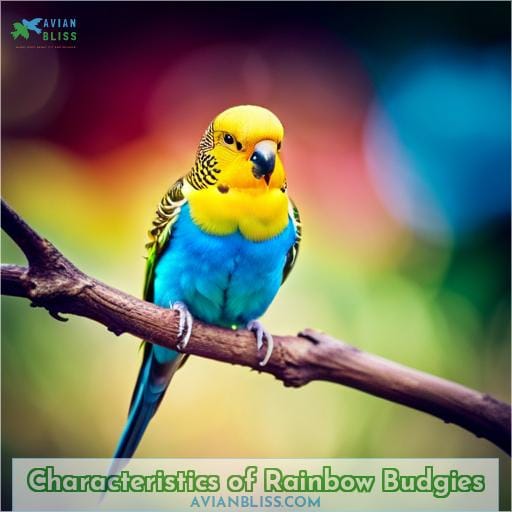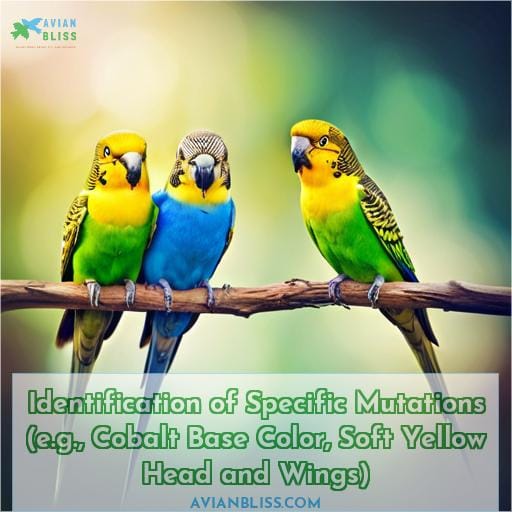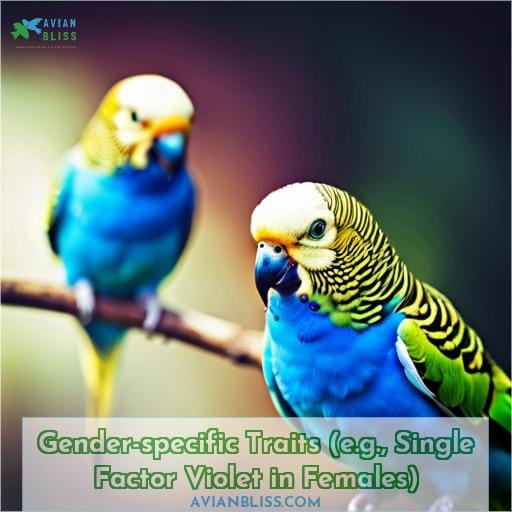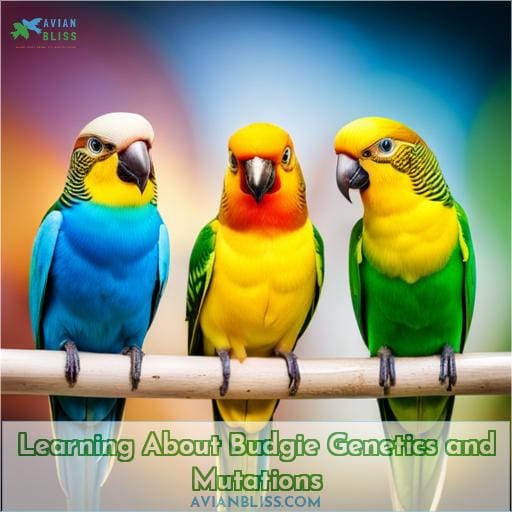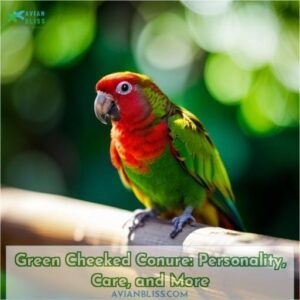This site is supported by our readers. We may earn a commission, at no cost to you, if you purchase through links.
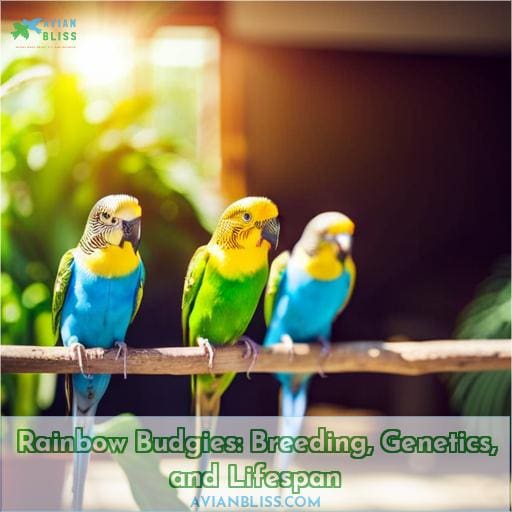 Imagine the vibrant colors of a rainbow in the form of budgies. If you’re curious about breeding, genetics, and lifespan of these captivating birds, you’ve come to the right place. From understanding specific mutations to learning about responsible breeding practices and factors that affect their longevity, this article will provide valuable insights for bird enthusiasts like yourself.
Imagine the vibrant colors of a rainbow in the form of budgies. If you’re curious about breeding, genetics, and lifespan of these captivating birds, you’ve come to the right place. From understanding specific mutations to learning about responsible breeding practices and factors that affect their longevity, this article will provide valuable insights for bird enthusiasts like yourself.
Table Of Contents
- Key Takeaways
- Characteristics of Rainbow Budgies
- Identification of Specific Mutations (e.g., Cobalt Base Color, Soft Yellow Head and Wings)
- Gender-specific Traits (e.g., Single Factor Violet in Females)
- Breeding Rainbow Budgies
- Learning About Budgie Genetics and Mutations
- Factors Affecting Budgie Lifespan
- Community Support and Reflection
- Frequently Asked Questions (FAQs)
- How can you distinguish between clearwing and full body greywing mutations in rainbow budgies?
- What are the specific characteristics of rainbow budgies that make them different from other budgie mutations?
- What steps should be taken before breeding rainbow budgies to ensure a diverse genetic pool and avoid inbreeding?
- What is the recommended age or level of experience before attempting to breed rainbow budgies?
- Are there any specific health concerns or considerations when it comes to breeding rainbow budgies?
- Conclusion
Key Takeaways
- Rainbow budgies have a cobalt base color and a soft yellow head and wing color.
- They have a diverse genetic pool, and responsible breeding practices are important.
- Identification of specific mutations and breeding challenges is a significant factor.
- Gender-specific traits, such as single-factor violet in females, can affect breeding and genetic diversity.
Characteristics of Rainbow Budgies
Rainbow Budgies: Breeding Challenges & Community Guidance
Characteristics of Rainbow Budgies
Rainbow budges exhibit a range of vibrant colors and patterns due to diverse genetics within their population. These captivating birds are known for their stunning visual appeal brought about by various color mutations like cobalt base coat complemented by soft yellow head feathers or wing hues taking on greenish undertones as they mature.
Moreover,
gender-specific traits contribute further uniqueness – female individuals typically sport single-factor violet markings which increases both beauty levels as well as overall attraction felt towards this particular variant!
Breeding Challenges
While it may seem straightforward at first glance given abundance found amongst wild populations where no specific selection pressures exist regarding mate choice criteria beyond reproductive compatibility requirements imposed upon species-level constraints dictated through biological processes such fertilization success rates achieved when interbreeding occurs between closely related kin members ensures viable offspring production occurs each generation cycle without fail– however even under natural conditions there still exists some level difficulty associated attempting produce desired outcomes simply because not all individuals possess proper genetic material necessary produce desired results due variations found amongst their genomes which result unique combinations being passed down subsequent generations – these challenges become even more pronounced when attempting recreate specific traits or color patterns intentionally through selective breeding practices designed manipulate gene frequencies within entire population budgerigars order achieve desired goals such as creating new mutations like Rainbow Budgies!
Identification of Specific Mutations (e.g., Cobalt Base Color, Soft Yellow Head and Wings)
To identify specific mutations in Rainbow Budgies, such as the cobalt base color and soft yellow head and wings, you can observe their unique physical characteristics.
- Color Mutation: The cobalt mutation is responsible for the vibrant blue color seen in some budgies. This mutation affects the pigment production in their feathers, resulting in a striking deep blue hue.
- Genetic Diversity: Breeding for appearance can sometimes lead to health considerations due to limited genetic diversity within certain traits like rainbow budgie breeding. It’s important for breeders to prioritize maintaining a diverse gene pool when working with these mutations.
- Breeding Challenges: Breeders face challenges when trying to produce specific mutations consistently while also ensuring overall health and vitality of offspring clearwing mutation.violet factor budgies require careful selection of parent birds based on desired traits but shouldn’t compromise overall genetic strength or well-being.
By understanding these identification factors related to color mutation, genetic diversity concerns, and breeding challenges associated with rainbow budgies,breeders can make informed decisions that promote both visual appeal and long-term health considerations within their flocks.
Gender-specific Traits (e.g., Single Factor Violet in Females)
Moving on from the identification of specific mutations in rainbow budgies, let’s delve into gender-specific traits that can be observed in these beautiful birds.
One fascinating trait found in female rainbow budgies is the presence of a single factor violet. This genetic inheritance adds an enchanting touch to their already vibrant plumage.
Color mutations play a significant role in breeding challenges and understanding the genetics behind them is crucial for successful breeding programs. The expression of traits such as single factor violet differs between males and females due to their unique genetic makeup.
Breeding for specific female traits requires careful selection and consideration of genetic diversity within the breeding pool. Breeders must ensure that they maintain healthy populations while also producing visually stunning offspring.
By exploring these gender-specific traits, breeders can further enhance their knowledge about rainbow budgie genetics, contributing to healthier bird populations with diverse color variations. Understanding how different genes interact allows us to appreciate nature’s intricate beauty displayed by our feathered friends.
Breeding Rainbow Budgies
When it comes to breeding Rainbow Budgies, extensive research and preparation are of utmost importance.
You must confirm the non-sibling status of your budgies from the breeder and ensure a diverse genetic pool for responsible breeding practices.
Commit yourself to continuous learning in order to become a knowledgeable breeder who prioritizes the health and well-being of these beautiful birds.
Importance of Extensive Research and Preparation
Before starting the journey of breeding rainbow budgies, it’s crucial for you to conduct extensive research and be fully prepared.
- Researching various techniques for breeding.
- Understanding the potential challenges that may arise during the process.
- Exploring genetic exploration to ensure healthy offspring.
- Preparing a suitable environment for your budgies.
Responsible ownership requires careful consideration of all aspects involved in breeding to avoid any careless practices that could impact their health or lifespan.
Confirmation of Non-sibling Status From the Breeder
When breeding rainbow budgies, it’s essential to confirm the non-sibling status of the birds from the breeder.
Breeder verification ensures genetic diversity and responsible pairing. It also helps avoid potential breeding challenges and genetically weak offspring.
As you embark on your learning journey in bird breeding, make sure to prioritize confirmation of non-sibling status before proceeding with any mating plans. This step ensures a strong foundation for healthy pet budgies with longer lifespans.
Diverse Genetic Pool and Responsible Breeding Practices
To ensure the health and genetic diversity of Rainbow budgies, it’s essential for breeders to maintain a diverse genetic pool and adhere to responsible breeding practices.
- Prioritizing Genetic Diversity:
- Breeding from a wide range of unrelated individuals helps prevent inbreeding and reduces the risk of hereditary issues.
- Responsible Breeder Vetting:
- Choosing reputable breeders who prioritize the well-being and genetics of their birds ensures ethical breeding practices.
- Debunking Mutation Misconceptions:
- Educating breeders about different mutations will help them make informed decisions based on accurate information while avoiding misconceptions that can harm budgie welfare.
Maintaining a diverse genetic pool is crucial when breeding Rainbow budgies as it promotes overall health and vitality in offspring. By selecting genetically distinct individuals for mating, breeders can minimize the risks associated with harmful recessive genes or inherited disorders.
Additionally, working with experienced avian veterinarians during breeder vetting processes can provide valuable guidance regarding appropriate pairings that maximize genetic variety while minimizing potential health concerns.
There are common misconceptions surrounding specific mutations in Rainbow budgies that may impact responsible breeding practices if not addressed properly. For example, some novice breeders may mistakenly believe certain mutations are more desirable than others without considering potential negative effects on bird health or longevity.
Breeding ethics should always be at the forefront when engaging in any type of animal husbandry practice like raising Rainbow budgies responsibly. Breeders must prioritize transparency by providing accurate information about lineage, genetics testing results if available, as well as sharing any known hereditary conditions within their lines.
Responsible selection criteria should focus not only on physical appearance but also on temperament traits such as friendliness towards humans.
By upholding these principles – maintaining a diverse genetic pool, adhering to responsible breeding practices, and vetting breeders with knowledge and experience – we can ensure the long-term health and well-being of Rainbow budgies.
This commitment to ethical breeding ultimately contributes to the overall lifespan of these beautiful birds.
Commitment to Continuous Learning and Responsible Breeding
Continuing to prioritize the well-being of your budgies, it’s essential to maintain a commitment to continuous learning and responsible breeding practices.
Stay up-to-date with genetic research and understand different mutations through online communities.
Seek community confirmation and genetic guidance before proceeding with breeding plans.
Embrace the complexity of breeding rainbow budgies by being prepared, connecting with knowledgeable avian vets, and continuously expanding your knowledge in this fascinating field.
Learning About Budgie Genetics and Mutations
As an aspiring breeder, it’s crucial for you to study various aspects of budgie genetics and mutations.
Understanding the different mutations, such as clearwing versus full body greywing, will help you make informed breeding decisions.
Seeking confirmation and guidance from online communities can be a valuable resource in your learning journey.
Appreciating the prompt responses and corrections from fellow enthusiasts fosters a supportive community dedicated to improving our understanding of budgie genetics.
Study Areas for Understanding Budgie Genetics
Studying budgie genetics and mutations is essential for understanding the complexities of breeding rainbow budgies.
- Genetic diversity and inbreeding risks.
- The visual characteristics of different mutations.
- The health and behavioral challenges certain mutations may cause.
- Seeking guidance from experienced breeders in online communities.
Importance of Understanding Different Mutations (e.g., Clearwing Vs. Full Body Greywing)
Distinguish mutations like clearwing from full body greywing as you learn budgie genetics.
Understanding these different mutations is crucial for ensuring genetic diversity and breeding ethics. It helps breeders make informed decisions about which birds to pair together to create healthy offspring with desirable color variations.
By being aware of the specific characteristics of each mutation, you can contribute to the overall well-being and longevity of budgies in your breeding program.
Seek community guidance and stay up-to-date on mutation awareness for successful breeding practices.
Seeking Confirmation and Guidance From Online Communities
To gain further knowledge about budgie genetics and mutations, you can seek confirmation and guidance from online communities of experienced breeders and enthusiasts.
- Online forums offer valuable insights from dedicated hobbyists and professionals.
- Experienced breeders generously share expertise to support responsible breeding.
- Community feedback provides critical guidance for identifying mutations.
- Discussions foster continuous learning and appreciation for diversity of knowledge.
- Together we build understanding to promote budgie health and proper care.
Appreciation for Community Responses and Corrections
You can appreciate the invaluable contributions of online communities in helping you learn about budgie genetics and mutations.
The support, confirmation, and corrections provided by fellow bird enthusiasts are truly remarkable.
Their willingness to share their knowledge and expertise is something to be grateful for.
Whether it’s confirming a specific mutation or correcting an understanding, the community responses play a crucial role in expanding your understanding of budgie genetics.
Thank you to all who’ve contributed!
Factors Affecting Budgie Lifespan
When it comes to the lifespan of budgies, there are several factors that can influence their longevity.
Variability in lifespans is observed, with budgies living anywhere from 2 years to over 15 years.
Diet and breeding practices play a significant role in determining lifespan, as an all-seed diet and prioritizing appearance over health can lead to shorter lives.
The availability of genetically strong budgies also affects their overall health and potential for a longer life.
Additionally, rainbow budgies may be more susceptible to certain health issues due to genetic weaknesses associated with specific suppliers or breeding practices.
Taking into account historical perspectives on longevity can provide insights into how modern breeding practices have affected the lifespan of these beautiful birds.
Variability in Budgie Lifespans
Budgie lifespans can vary due to several factors.
A budgie on an all-seed diet may live for around 5 years, while those with a varied diet could reach up to 10 years.
Regular flying can extend their lifespan to about 13 years, whereas limited pellet consumption may result in a lifespan of around 14 years.
Unfortunately, some budgies have short lives due to AGY-related deaths or old age issues like heart attacks and being egg bound.
Influence of Diet and Breeding Practices on Lifespan
The longevity of your pet depends heavily on both its nutrition and the responsible practices of its breeder.
An all-seed diet is linked to shorter budgie lifespans of just 4-8 years, but genetically strong budgies on nutritious diets of pellets, fruit, vegetables, and egg can live much longer.
However, some pet store budgies bred for appearance over health may have shorter lifespans around 2 years even with proper diet, emphasizing the need for responsible breeding practices focused on longevity rather than just appearance.
Impact of Genetic Strength and Availability of Genetically Strong Budgies
Depending where you’re living, the availability of genetically strong budgies may be limited due to modern breeding practices emphasizing appearance over health. Genetic diversity, bottleneck, and inbreeding can create weakness, predisposing to issues and shorter lifespans in pet store budgies.
Potential Health Issues Associated With Rainbow Budgies
In addition to genetic factors, there are a number of potential health issues associated with rainbow budgies that can affect their lifespan.
These include respiratory illnesses, which can be triggered by stress or inbreeding, and can lead to shortened lifespans.
Pet store budgies and those on an all-seed diet are also more likely to have shorter lifespans.
Proper veterinary care, including early intervention for respiratory infections, can help to improve the lifespan of rainbow budgies.
Historical Perspective on Budgie Longevity
Looking back at the historical perspective on budgie longevity, it’s interesting to note how various factors have influenced their lifespan over time.
- Limited pellets: Decades ago, when pellet diets weren’t as readily available, budgies had shorter lifespans.
- Regular flying: Budgies that had the opportunity for regular flying and exercise tended to live longer lives.
- Strong genetics and less inbreeding: In the past, emphasis was placed on maintaining strong genetics through careful breeding practices with minimal inbreeding.
- Modern breeding emphasizing appearance: With modern breeding practices focusing more on appearance rather than health, some baby budgies may be genetically weaker leading to decreased longevity.
These factors highlight how changes in diet options, exercise opportunities, genetic diversity and breeding priorities have played a role in shaping the lifespan of these beautiful birds throughout history.
Community Support and Reflection
As an avian veterinarian, you understand the importance of community support when it comes to finding a reliable and knowledgeable avian vet.
You’re grateful for online forums and information sharing platforms that provide valuable resources and guidance in caring for budgies.
Reflecting on their vulnerability and small size, you recognize the need to prioritize budgie health through proper care, early intervention, and expert assistance.
Sharing your personal experiences and lessons learned can help others navigate the complexities of budgie ownership while promoting their well-being.
Importance of Community Support in Finding an Avian Vet
When it comes to ensuring the health and well-being of your rainbow budgies, finding a knowledgeable avian vet is essential for their care.
The support of an online community can be invaluable in locating a reputable avian vet who specializes in bird health.
Timely care and early intervention provided by an experienced veterinarian are crucial for the well-being of your budgies.
Expressing gratitude for the healing thoughts received from fellow bird enthusiasts can create a sense of camaraderie within this supportive community.
| Importance |
|---|
| Gratitude |
| Online Community |
| Avian Vet |
| Timely Care |
Gratitude for Online Forums and Information Sharing
With the support and guidance of online forums, you can find solace in connecting with fellow budgie enthusiasts and gain valuable insights into caring for your rainbow budgies.
Online communities provide a wealth of information and resources to help you navigate the complexities of breeding, genetics, and lifespan.
Show appreciation for this community support by actively engaging in discussions, sharing experiences, seeking advice when needed, and contributing knowledge to foster a sense of unity among bird lovers.
Reflecting on the Vulnerability and Small Size of Budgies
As members of the budgie community, it’s crucial to acknowledge and reflect on the vulnerability and small size of these cherished birds.
Stress from moving can have detrimental effects on their health, making early intervention essential for their well-being.
Bonded pairs require critical bonding and taming phases that may be disrupted by illness or other factors.
The small size of budgies makes them susceptible to a range of challenges, emphasizing the need for proper care and support within our community.
Sharing Personal Experiences and Lessons Learned
One important lesson to learn from personal experiences is the value of community support and reflection when it comes to caring for rainbow budgies.
Here are some key insights gained through these shared experiences:
- Health issues can arise unexpectedly, necessitating a vet visit.
- Health concerns during the bonding and taming phase can disrupt progress.
- Emotional distress arises from separating bonded pairs for medical care.
- Gratitude towards online communities that provide support and information in times of need, fostering reflection on lessons learned along the way
Encouraging Others to Prioritize Budgie Health and Proper Care
To ensure the health and well-being of your budgie, it’s essential that you prioritize their care and seek community support.
Proper budgie care involves:
- Providing a balanced diet
- A clean living environment
- Regular vet check-ups
- Mental stimulation
It’s important to take responsibility for their physical and emotional needs.
Engaging with fellow bird owners in online forums or local bird clubs can provide valuable insights and support on proper care practices.
Frequently Asked Questions (FAQs)
How can you distinguish between clearwing and full body greywing mutations in rainbow budgies?
To distinguish between clearwing and full body greywing mutations in rainbow budgies, observe their wing coloration.
Clearwings will have lighter wings compared to the body, while full body greywings will have darker wings matching the body color.
What are the specific characteristics of rainbow budgies that make them different from other budgie mutations?
Rainbow budgies, with their cobalt base color and soft yellow head and wing color, possess a distinct visual rainbow mutation.
The female trait includes at least one factor violet.
Distinguishing between clearwing and full body greywing requires specific knowledge of their characteristics.
What steps should be taken before breeding rainbow budgies to ensure a diverse genetic pool and avoid inbreeding?
To ensure a diverse genetic pool and avoid inbreeding when breeding rainbow budgies, conduct extensive research, confirm non-sibling status from the breeder, connect with a knowledgeable avian vet for guidance, and prioritize caution and preparedness.
What is the recommended age or level of experience before attempting to breed rainbow budgies?
Before attempting to breed rainbow budgies, it is recommended that you have the wisdom of a centuries-old avian sage and the experience of a bird whisperer who can communicate with feathers.
Are there any specific health concerns or considerations when it comes to breeding rainbow budgies?
When considering breeding rainbow budgies, it’s essential to be aware of potential health concerns.
Breeding can amplify genetic weaknesses and increase the risk of respiratory illnesses.
Consulting with an avian vet is crucial for a successful breeding journey.
Conclusion
In the captivating world of Rainbow Budgies, the vibrant colors of a rainbow come to life.
Understanding the specific mutations, responsible breeding practices, and factors that affect their lifespan is crucial for bird enthusiasts.
From identifying unique traits to learning about budgie genetics, this article has provided valuable insights.
By prioritizing their health and proper care, you can ensure these captivating birds thrive in their colorful splendor.
So, dive into the world of Rainbow Budgies and embark on an enchanting journey.

